I recently received an email from an artist recommending I check out their current show up in NYC. As with all of life, serendipity reared its head. While I have not met Charles McGill, his work felt similar to some recent work that I have obsessed over (punching bags by artist Jeffrey Gibson). A compelling combination of art and sports, with a violent and gentle presentation of the irrational political structures of race. While Gibson covers actual punching bags with the ancient craft of beading and significant patterns of Native American Indians, McGill repurposes golf bags by decorating them or distorting them into images of lynching.
Initially his sculpture seems macho given that golf is a sexist sport, and the fact that some highly manipulated leather and metal pieces take great physical strength to execute. On the flip side, the work has a very feminine and decorative quality: it is a bag after all, and the quilting and placement of color in some of the recent work feels very intentional and less “abstract expressionistic”.
On no uncertain terms race has been on my mind for the last six months, and especially in the past 24 hours given the news from South Carolina. That said, as a white women of a certain age and class, my commenting on these things, on first blush, feels irrelevant and my outrage is distorted. Which is why I was thrilled to receive the email and learn of Charles’ life work, and see that his art visually spins an important dialog around the issue of race and class structure. While he is not reporting or illustrating the issues of the day, his work certainly offers a soft place to wrestle some damned gnarly issues.
Since I could not make it to see his show up through April 18 at Pavel Zoubok Gallery, I thought necessary to at least have a Q&A with him, so I could learn more about his history with golf, art and the evolution of his work. Below are my questions and his generous answers. Thank you Charles for your time and your beautiful work!
CHE: Where were you raised?
CM: I was raised in Binghamton, NY., hometown of Rod Serling, creator of The Twilight Zone. Binghamton was the inspiration for the series and woven throughout many episodes. My family still lives in Binghamton. I spent the Easter holiday there. My mother’s house is just a few blocks from the hospital in which I was born. It’s always very thought-provoking for me to be near that building. It was my first home albeit it a brief stay!
CHE: Do you have any Irish descent (McGill)?
CM: I was in Scotland back in 2002 and I asked some Scots if McGill was an Scottish name and they told me it was more Irish. Then I asked some Irish travelers I met if it were an Irish name and they said it was more Scottish. The mystery only deepened… The actually verbal history of my family only goes back to my great grandfather who, for reasons yet unknown, shared nothing about his past to anyone. He was a closed door to the family lineage that preceded him.
CHE: When was the first time you played golf?
CM: I played in earnest around 1993. Over the years I played really well without having taken a lesson. It was all creative and imaginative for me… I played by feel. Once I started taking lessons and working in golf I became to enjoy playing less and became a little too conscious of how to swing the club and played less by intuition…. I have a temper, too, which simply isn’t productive when it comes out on the golf course. These days I would prefer to use whatever emotion I would waste on the golf course in the studio where it’s put to much better use. I still play, but I’m a little detached from the process because I’m think about the studio and what I have in progress.
CHE: When did you first know you wanted to be an artist?
CM: I was about 6. I was at the boys club, and each of us had a small wooden cutout of a dog. The guy conducting the class in the wood shop cut each silhouette for the kids, and we all lined up for him to draw the lines inside the edges that made up the features of the dog. When it was my turn I refused to give it to him and told him I wanted to draw my own. He said I couldn’t, and I still refused – he finally gave up and let me draw my own dog. I drew it better than him and he knew it! I’ve been making art in some form or another before that and ever since. I’ve never done anything for the pure satisfaction of it longer than I have been making art.
CHE:What are the questions at the heart of your practice, or this particular suite of recent work?
CM: The most urgent and longest pursued question is how to make something original and redefine the notion of ‘black art’. There are smaller questions, too, but in a nutshell, I have always wanted to make work that discusses some of the same issues but does so in an entirely original way – work made almost in a vacuum and with little or no regard for trends or current schools of thought. I am selfish that way and try my best to trust my process. I didn’t put all that time in at college learning all of this stuff so that I could be a working artist, and to just come out of school and start doing what everyone else was doing. I think I’ve been successful so far and would not change a thing. Joe Lewis wrote about my work in Art in America in 2001, “The work discovers new conceptual mass in the well-worn territories of race and representation.” It was a nice to read that because it reaffirmed my approach and acknowledged something that I had secretly been trying to do. This body of work attempts to deepen that resolve and explore things in ways that are even more challenging and disruptive to any comfort zones I may still have. There’s nothing more boring and unsatisfying for me than to work safely in a comfort zone.
CHE: In three words, what does your art represent?
CM: In three words (or less) my work represents – My perseverance.
CHE: With the events that occurred this past summer at Ferguson (and seemingly too often and elsewhere), has this affected your practice at all?
CM: The events in Ferguson this past summer gave me a sense that I am doing the right work right now. I didn’t have to make a special piece and ‘comment’ on those events – my work is contextually relevant already. I am not a newspaper. I did one piece that was consciously commenting on a current event and that was three years ago during Hurricane Sandy – I made a piece called “Angry Atlantic”. Other than that, the political/racial stories we see in the news is in the DNA of my work so I don’t ‘report on’ events like some artists I see who make art that directly reflect specific events we see on the news. As far as I’m concerned the work an artist makes either reflects the time in which they live or it doesn’t. It shouldn’t have to rely on a news story.
CHE: Since the golf bag smacks of class and racial bias, are you ever concerned about using the “language of oppressor” (the golf bag) in work that is exploring racial tension (like your performance work you did with the militant black golf club fellow “Arthur Negro”).
CM: I think using the golf bag as motif has big ramifications to it, and can easily be seen as something it isn’t. In other words, I do think the golf bag is ripe with its own historical baggage and serves both as object and subject, but I never really approached it as such. Yes, the first bag I ever did was called “Lynch Bag”, a golf bag plastered with images of lynching. That was totally an attempt to draw comparisons between the object and the imagery. That’s not to say I wasn’t conscious of the racial elements being married to the object, but I was more interested in the beauty of the objects I was making than I was the content. I wanted to make work that was on the level of something like the album by Stevie Wonder, “Songs in the Key of Life”. If you take the lyrics and political content away from that album and you just have the music, then what you have is the beauty. With the political and cultural nature of the lyrics you have something to compare with the beauty of the music, and in that comparison is the dialogue the album evokes. So I wanted my objects to be beautiful first, politically relevant and engaging second.
The slyly titled Blue Menace (2012) can easily be read as a clown Klavern, with a white bag doing double duty as a hooded straightjacket. A central, sky-blue figure sports a literal pair of balls, adding sexual threat (and serious laughs) to the composition while recalling Jasper Johns’s Painting with Two Balls (1960), that gay artist’s spattered riposte to the machismo of the abstract expressionists. Throughout, there are whiffs of the anonymous cowardice of the Klan and the toadying conformity of the country club. – RC Baker of the Village Voice on Charles McGill’s work.
CHE: Which black (or white) artists do you most admire and align yourself with from the perspective of an art historical lineage. I’ve seen references in reviews of your work to John Chamberlain, and others and wondered if that is how you see it, or it is seen?
CM: I truly stumbled into the comparison with John Chamberlain – I wasn’t planning on deconstructing golf bags and reassembling them into objects like I have created in the past that speak to the aesthetic kinship with artists like Chamberlain. But since my work has evolved I have seen similarities between it and Nancy Grossman, Lee Bontecou, Sal Scarpita and others. I have made references to other artists in titles such as “Goat, Bull, Rooster, Horse”. That piece is a direct reference to my 25 years of watching the film, The Mystery of Picasso. While making that piece that’s all that I thought of – how Picasso seamlessly merged the likeness of people and animals with such virtuosity that it seemed magical – that we were seeing the identities of several things at the same time. Let me be clear I am not comparing myself to Picasso! I am only saying how impactful that film was on my work over the years as I often think about the process one witnesses when they watch him work. He never trusted himself enough to be satisfied with anything that was less than strange and vulgar.
CHE: Do you ever show your drawings with your sculpture?
CM: My drawing are separate from my current work altogether. I think about incorporating drawing sometimes and may do so in there coming months. I am not sure how but I may look into it. I have a large museum show next year and that would be a good time to show some drawings along side the assemblages and free standing works.
CHE: Can you speak to the work/art/life balance that you have seemingly mastered? I noticed in your site bio and other writeups on you, you have an incredibly diverse pool of work experiences. Your work has been compared to John Chamberlain, and he too had a random work history where he supported himself as a hairdresser and makeup artist in Chicago before he was an artist full stop.
CM: I’m not sure I’ve mastered that balance yet because I still worry too much. Over the years I have tried to maintain an unwavering belief in my abilities and my goals. Tough times, b-jobs, unemployment, etc. all seemed in the moment to not serve the greater purpose of being an artist and a teacher. It’s what I needed to do at the time to take care of my immediate needs. Who would have thought that my applying for a golf retail job back in 1996 would have served the greater good of moving me closer to the creative practice I have today? I’ve had so many jobs I can’t count them all but here’s a list of a few –
juice bar operator, show salesman, telemarketer, bouncer, demolition, house painter, art store department manager, waiter, bar back, retail, country club, elementary school art teacher (hated that!), personal assistant, illustrated, private drawing teacher, gallery assistant, house painter….
CHE: Have you or would you ever be interested in collaborating with other artists?
CM: I’ve collaborated with other artists but only in so far as their collaborative efforts were in support of a project I’d hired them for – specifically my ‘Playing Through’ performances in the streets of Harlem. They were trusted to convey the attitude of the piece while bringing their own style and attitude to the piece. We did some collaborative things when I was at the school of the visual arts for a club we formed called “Art Against Apartheid” (yes, I’m that old). We did a big banner with a stop sign that had the word “Racism” spray painted across it. That was definitely a collective effort, but the idea was mine after hours of putting our heads together exploring the use of images that were all too literal. Professionally I am always open to working with others, it just hasn’t come up beyond my own performative projects.
+++++++++++
Charles McGill Territories
Pavel Zoubok Gallery
March 19 – April 18, 2015
531 West 26th Street
New York, NY
212.675.7490
Further:
Artist’s web site
A nice write up of Charles’ work by Walter Robinson “The Golf War”
Charles discussing his process most recently here.
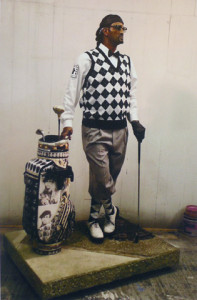
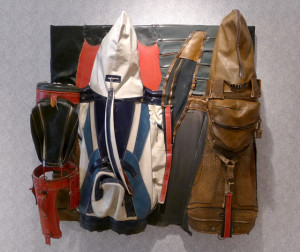
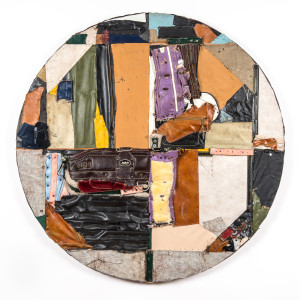
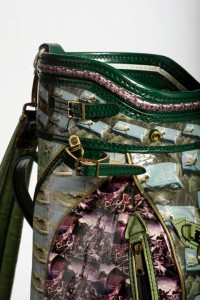
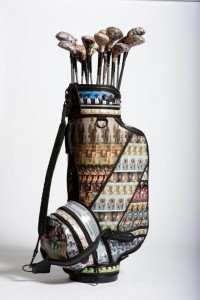
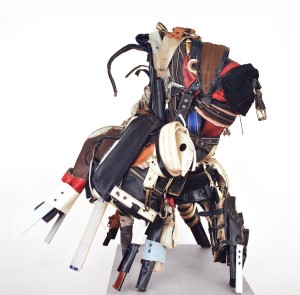
0 Comments
Would you like to share your thoughts?